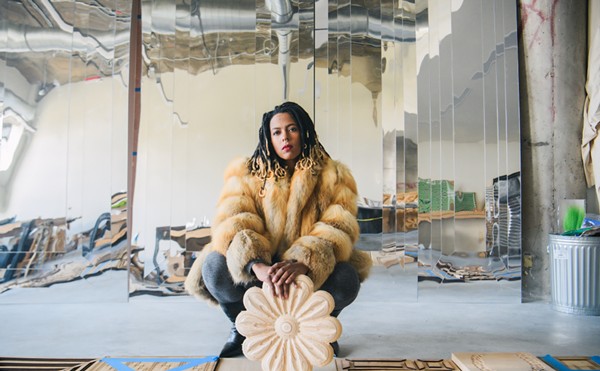Two artists are staking their claim in a fenced-in compound on Oakland Avenue, just a stroll north of Grand Boulevard in Detroit. Their names are Steven Kuypers and Steven McShane, and their headquarters is called the Fortress.
Dressed in neon spray paint, the 6,000-square-foot brick studio and residency space even has multicolored arworks perched atop. Visitors gaining entry to the parking lot will be overwhelmed by the amount and variety of vehicles, equipment and other oddities on display.
Parked on the gravel are various private cars, a flatbed truck, another truck — with an industrial-size boom — a half-dozen motorcycles and two 12-foot-tall gantries, one with an artwork suspended from it that appears to be made of two-dozen engine blocks, welded together. And there’s also a small house — on wheels, no less — in which a friend has taken up residence, as well as a bizarre-looking set of kilns dubbed the “Noborigama.”
A tour of the various shops in the building is equally dizzying. First is a metal shop where fabricators can use almost every metal process available, with a foundry that pours aluminum and bronze; a blacksmithing station with a gas forge, a coal forge and a power hammer; TIG, MIG and arc welders; a Bridgeport mill; a C&C plasma cutter — basically whatever equipment the artists have been able to beg, buy or barter for.
There’s also a fully functioning ceramics studio, with two oval kilns and three potter’s wheels. Next is a wood shop, with band, table and chop saws. A jewelry station shares a room with various prototyping equipment, including a C&C foam mill and a 3-D printer.
This unusual array is the fruit of eight years of work for the duo. A native of Tawas City, Mich., a town on the shores of Lake Huron, McShane befriended Kuypers at 22, when he came to Detroit to study blacksmithing at CCS. He laughs about those days, saying. “We were two poor bastards wondering how to pay for school, keep a roof over our heads and still have studio space.” He says the sprawling space was perfect for them. With dry wit, he points out that the equipment used in metalworking is “not light or small.” When the landlord offered to sell them the space three years ago, Kuypers and McShane seized the opportunity.
As co-owners, McShane and Kuypers have a strong partnership. McShane says they get along so well because they have such different backgrounds. Though McShane’s work has become more conceptual (see the soft blooms of neon color thrown by his work on display at the current show at Detroit’s Red Bull House of Art), his background is that of a craftsman. His partnership with Kuypers, who studied fine arts, has tempered his materialism a bit. “I get obsessed with steel. With blacksmithing it, welding, pouring, machining it. Whereas Kuypers is more an artist, somebody who comes up with an idea, then uses any process to achieve it.”
In addition to feeding off each other, artistically, they also host artists-in-residence at the Fortress, trading space and equipment for the energy these fledgling artists provide. “To be an artist,” McShane says, “you have to have the creative juices flowing. Having an artists’ community with an ever-changing movement of artists coming through the residency program is like a continual breath of fresh air. You feed off it. That’s important, because when you’re involved in art, you have to be on your toes. You can get stale pretty quick.”
To pay the bills since graduation, McShane has fallen into some pretty unusual niche work, including restoring antique armor, wrenching as a mechanic at Ferndale’s Detroit Brothers, or doing what he does now, working on vintage racecars. Seeing him at the bar, with his full beard and hands that look fresh from the gearbox, you might not think of him as a fine artist, but it’s clearly his passion.
“My father worked at a scrap yard,” McShane explains. Joining his father at work, McShane continually picked up bits of scrap that drew his interest. So many that he one day realized he had two dresser drawers full of these treasured objects.
“I just threw them all out,” he says. “It was a small town. There weren’t a whole lot of open-minded people. What are they going to think, instead of having shirts and socks in his drawers, he has this? I threw it all away and didn’t think about it for years.”
Later, however, he realized his upbringing overlapped other artists who also appreciated what he calls “assemblages, accidents, finding something very beautiful about letting it be what it is.”
That fascination plays an obvious role in McShane’s love for his Detroit studio. “I’ve been to a lot of other cities, but I always tend to miss what Detroit is today. Here, I see freedom, practicing artists working looking for something more. Detroit provides that freedom. Nobody stops me from working.”
He smiles, thinking of an apt explanation. “One time, Kuypers was driving around in our lot using a boom truck, using it to place art on the roof. Now, in Ann Arbor, this wouldn’t fly. Somebody’d come by and ask questions. But here? It’s just super-free.”
Michael Jackman is managing editor of Metro Times. Send comments to [email protected].





